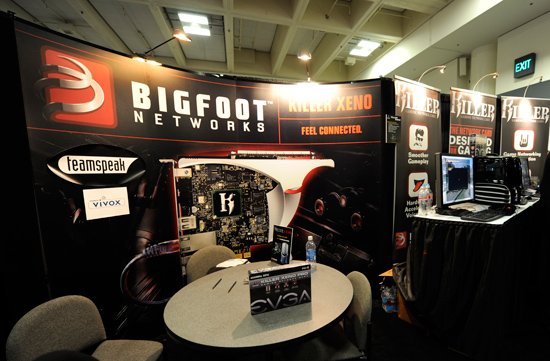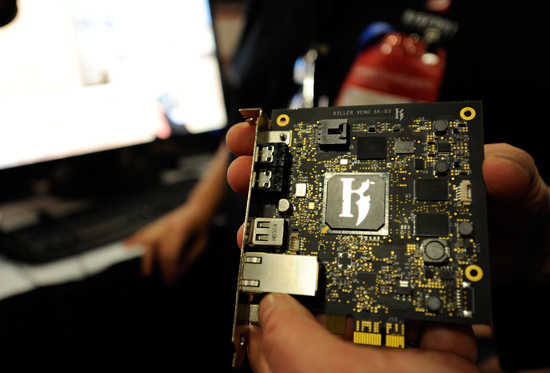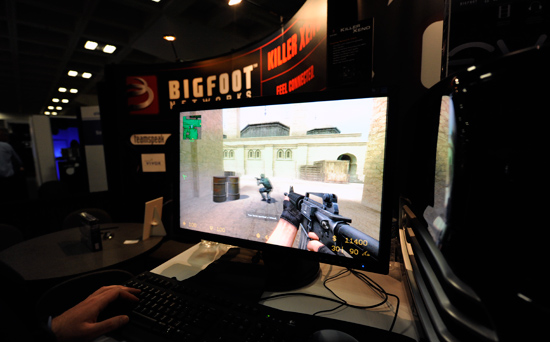Nintendo's Development Secrets, Cloud Gaming & new Killer NIC - GDC '09
by Anand Lal Shimpi & Derek Wilson on March 26, 2009 12:00 AM EST- Posted in
- Trade Shows
Bigfoot is Back: Killer Xeno NIC
You all remember Bigfoot Networks, right? The makers of the Killer NIC? They’re back with a cheaper, updated product: the Killer Xeno.

The Killer Xeno is a network card with an on-board processor, memory and lightweight Linux OS. It serves as a packet accelerator and voice/UDP offload processor for your PC. The idea is that the Windows audio and networking stacks are horribly inefficient and optimized for file transfers, not low latency gaming. The Killer Xeno bypasses the Windows audio/networking stacks and uses its own lightweight stacks to handle all voice chat/networking requests, theoretically translating into lower pings while gaming with voice chat enabled.

The new Killer NIC adds support for voice chat, a feature the original didn't have
We’ll be looking at the Killer Xeno in the not too distant future. Despite there being demos at the booth, none of them were the necessary Killer Xeno vs. No Killer Xeno tests to determine the usefulness of such a thing. We’ll put the card through its paces soon enough.

Counterstrike was the test of choice. Unfortunately there was no reference point for the demo.

The Killer Xeno software includes an application that will let you throttle bandwidth to running processes/applications. The utility can also serve as an automatic alert/defender against undesired outbound or incoming network connections.
The Xeno will ship next month starting at $130.










38 Comments
View All Comments
arturnowp - Friday, March 27, 2009 - link
Resolution is not that big problem. Imagine 720p with 16x AA. There is resolution bound caused by netword bandwidth not because of data center perfomance.MrSAballmer - Thursday, March 26, 2009 - link
Interesting stuff here, especially the fishnet-girls!http://fakesteveballmer.blogspot.com">http://fakesteveballmer.blogspot.com
spuddyt - Thursday, March 26, 2009 - link
I mean, a fat red plumber jumping on mushrooms....drwheel - Thursday, March 26, 2009 - link
That's how the article reads anyway.It amazes me that bigfoot networks is still in business. Another killer nic product that delivers marginal improvements that are rivalled by a $25 intel card:
http://forum.ncix.com/forums/topic.php?id=1304406">http://forum.ncix.com/forums/topic.php?id=1304406
And a streaming video game system! Awesome. Seeing as how gamers like myself already complain about latency on lcd monitors that claim to have single-digit ms response times (not always true), or who can easily notice a different between at 20ms versus a 100ms ping time to a game server, I'm sure throwing another 80ms of lag in there because your game is being pre-rendered elsewhere won't hurt either! Haha.
What a joke. Is this the best stuff there is to report about at GDC?
SSDMaster - Thursday, March 26, 2009 - link
They've really done something unique with onLive though... you gotta hand it to them.They've created a new type of lag.
Before you just had to wait till the server showed you where your enemies were, but NOW you get to wait to see your character turn every time you hit the control stick...
GENIUS!
drwheel - Thursday, March 26, 2009 - link
And let's not forget the other issues with this platform aside from latency. This company better have a ginormous data center with tons of mid to high-end systems, each one with a dedicated gfx card for each player, and gobs and gobs of bandwidth on a very reliable backbone. We're talking about AIG bailout money here.This entire venture just sounds like something that will never get off the ground. And even if it does, there is a list of logistical issues that will cause it to fail. Sorry, but this sounds like the next "Sega Channel" or better yet... Phantom game console.
Good idea, but there is no way it will ever work. Atleast, not until this country's network infrastructure is improved to a point where coast-to-coast latency is in the single-digit millisecond range, and everyone has atleast 10Mbps bandwidth in their home (read: not for at least another 10 years).
bespoke - Thursday, March 26, 2009 - link
"And let's not forget the other issues with this platform aside from latency. This company better have a ginormous data center with tons of mid to high-end systems, each one with a dedicated gfx card for each player, and gobs and gobs of bandwidth on a very reliable backbone. We're talking about AIG bailout money here."Right - this is the point I don't understand. We've got to be talking about quite huge hardware investment per user to run these things. Maybe $500 of hardware per user? Are these guys really going to spend that much money up front? Are they going to be able to recoop that money? Will they upgrade hardware every 6-12 months to stay up with games?
baba264 - Thursday, March 26, 2009 - link
I believe I may be able to offer some insight on this question. In my opinion you forget three major facts.The first one is that the game resolution offered are calibrated for the tv. Either standard 800x600 tv, or 1024*720 HD tv, but either way, compared to the kind of resolution we're talking about in a high end gaming rigg, this is very low.
The second fact is that they're probably not going to be running their games on indivdual pc, but rather on a cluster of workstations with high end graphic cards and maybe dedicated hardware for physics rendering. Considering the resolutions involved, one may be able to run quite a few instances of a game on a single machine.
The third is that, given the resolutions offered and the latency issues, this seems to me like a product aimed much more at the console crowd and maybe the notebook crowd than at the pc gaming one.
To sum it up there must be some large input of money to start up the thing, but if it's well designed, one may be able to add to load capacity without changing the architecture, just by plugging in new machines. So the initial investment is just a few machines and all the design and software to run the thing. Furthermore, one does get some economy through scaling so the number are not as bad as they seem. And since it's aimed mostly at the console crowd, that's more used to latency, the add up might not be an issue in most games.
So all in all, seen as something to replace your console (and not your pc) or to get into gaming if you don't have any hardware yet, this seems like a fairly good idea to me. However, I am concerned, as others have expressed before me, with the impact this traffic will have on Internet as a whole if this service becomes popular.
araczynski - Thursday, March 26, 2009 - link
i'm really hoping onlive gets traction, it would catch the industry off guard at the least, but i'd think for the most part the developers would love it.great way to fight piracy and gamestop, not to mention opening up a whole new potential userbase for developers to sell to, i.e. those that don't want to waste time/money on buying/building crazy gaming rigs.
the 720p limitation at the moment does worry me a bit, but then again that's probably not that big of an issue when the device is hooked up to say a laptop screen, as opposed to a tv/monitor.
in any case, broadband speeds are only increasing, even in the backwater US, so full 1080p shouldn't be all that far off.
The0ne - Thursday, March 26, 2009 - link
Speed increase with download/upload caps. Yea, good combo alright.